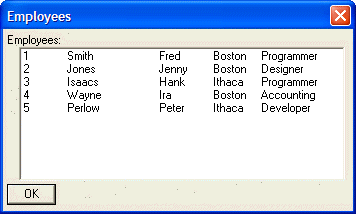List Box (Multi-Field Multi-Column) Control Syntax
Syntax
Arguments
- ^
Character. The leading [ and trailing ] and the ^ characters are required.
- Width
Numeric. The width of the control.
- Height
Numeric. The height of the control.
- Variable_Name
Character. The name of a character variable to receive the user selection, or a numeric variable to receive the index value of the selected radio button. The index of the top-most button is 1.
- n1,n2 ... nN
Integer values that control the size of each column in the list box. For example, if you specified a formatting string of |1|2|, the list box would be divided into two columns. The total width of the list box would be 3 'logical' units (1+2). Column 1 would be 1 logical unit wide, (or 1/3 of the total width of the list box), and column 2 would be 2 logical units wide (or 2/3 of the total width of the list box). A formatting string of |2|5|2|7| would divide the list into 4 columns, with column widths respectively of 2/16ths, 5/16ths, 2/16ths and 7/16ths or the column width specified by the size parameter.
- Choices
Character. See Choices Syntax. You must either use the use {DATA} command or the K Directive to preserve the formatting of selected items.
- Event
Character. Optional. See Event Syntax.
- Enabled
Logical. Optional. See Enabled Syntax.
Description
The Tabbed List Box control displays a list box with multiple columns. The entries in the choice_array or choice_variable are separated into columns with the "|" (tab) character.
Example
Dim employees100 as C
names = <<%a%
1 Smith Fred Boston Programmer
2 Jones Jenny Boston Designer
3 Isaacs Hank Ithaca Programmer
4 Wayne Ira Boston Accounting
5 Perlow Peter Ithaca Developer
%a%
employees.initialize(names)
result=ui_dlg_box("Employees",<<%dlg%
Employees:;
[.64,10selected^|1|1|3|1|1|employees] ;
<*&OK>
%dlg% )See Also
